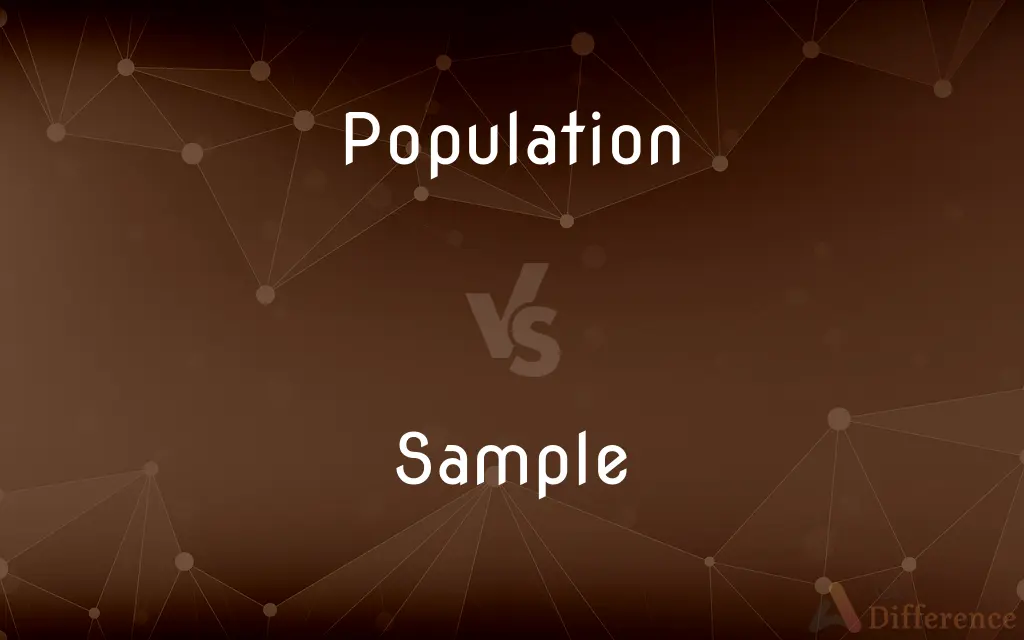Population vs. Sample — What's the Difference?
By Urooj Arif & Fiza Rafique — Updated on March 25, 2024
Population encompasses the entire group under study in research, while a sample is a subset of the population selected for actual observation.

Difference Between Population and Sample
Table of Contents
ADVERTISEMENT
Key Differences
A population refers to the complete set of items or individuals with a characteristic of interest, for any given study or survey. It represents the total group from which researchers might want to gather data. On the other hand, a sample is a portion of the population selected for analysis. The main reason for sampling is the impracticality of studying the whole population due to constraints like time, cost, or accessibility.
While the population encompasses all elements relevant to a particular research question, making it broad and often hypothetical, a sample is more concrete and manageable, allowing for actual data collection and analysis. Researchers aim for the sample to represent the population as closely as possible, despite being a smaller group.
Accuracy and generalization are key differences between the two. Findings derived from a population can be considered perfectly accurate for that group, but obtaining such data is usually unrealistic. Conversely, results from a sample are generalized to the population, with a margin of error acknowledging the fact that a sample might not capture the population's full diversity.
In terms of analysis, studying a population eliminates sampling error because it involves examining every single entity within the group. However, this is often not feasible or necessary. Sampling, while introducing a potential for error, allows for efficient and practical research within available resources.
The selection process also differentiates them. When dealing with a population, there is no selection; the entire group is of interest. In contrast, samples require a rigorous selection process to ensure that they are representative of the population, utilizing methods like random sampling, stratified sampling, or convenience sampling.
ADVERTISEMENT
Comparison Chart
Definition
Entire group under study
Subset of the population analyzed
Purpose
Theoretical understanding of the group
Practical observation and analysis
Scope
Broad and inclusive
Narrow and selective
Data Collection
Impractical for large groups
Practical and manageable
Error Margin
None (all elements are included)
Present (only some elements included)
Compare with Definitions
Population
The entirety of a group that shares a common characteristic.
The study's population consisted of all undergraduate students.
Sample
A portion of the population selected for examination.
The sample of 200 participants was drawn from the city’s population.
Population
The entire collection of elements from which data can be drawn.
The population for the survey was all employees of the company.
Sample
A subset of data chosen for analysis.
The sample included randomly selected customer reviews.
Population
A hypothetical concept representing the whole scope of study.
The theoretical population included every possible outcome of the experiment.
Sample
A selection used to infer characteristics about the population.
The study's findings were based on a carefully chosen sample.
Population
A complete set of data under consideration.
The researcher analyzed the population of responses to identify trends.
Sample
A representative group drawn from the larger population.
The survey’s sample accurately reflected the age distribution of the population.
Population
The total group of individuals or items of interest in a study.
The population of the study includes all registered voters in the city.
Sample
A smaller, manageable group selected for research purposes.
Researchers chose a sample of schools across the country for the study.
Population
All the inhabitants of a particular place
The island has a population of about 78,000
Sample
A small part or quantity intended to show what the whole is like
Investigations involved analysing samples of handwriting
Population
A community of animals, plants, or humans among whose members interbreeding occurs
Fluctuations in populations of voles and lemmings
Sample
A sound or piece of music created by sampling
Piano samples
Population
A finite or infinite collection of items under consideration.
Sample
Take a sample or samples of (something) for analysis
Bone marrow cells were sampled
Population
Each of three groups (designated I, II, and III) into which stars can be approximately divided on the basis of their manner of formation
The motions of Population II objects
Sample
Ascertain the momentary value of (an analogue signal) many times a second so as to convert the signal to digital form
The input signal must be sampled at twice its highest frequency
Population
All of the people inhabiting a specified area.
Sample
A portion, piece, or segment that is representative of a whole
Showed samples of a new stretch fabric.
Population
The total number of such people.
Sample
(Statistics) A set of data or elements drawn from a larger population and analyzed to estimate the characteristics of that population. Also called sampling.
Population
The total number of inhabitants constituting a particular race, class, or group in a specified area.
Sample
A usually digitized audio segment taken from an original recording and inserted, often repetitively, in a new recording.
Population
The act or process of furnishing with inhabitants.
Sample
One of a series of pieces of data representing a digitized approximation of an analog signal.
Population
(Ecology) All the organisms of a given species interacting in a specified area.
Sample
To take a sample of, especially to test or examine by a sample
The restaurant critic who must sample a little of everything.
Population
(Statistics) The set of individuals, items, or data from which a statistical sample is taken. Also called universe.
Sample
To use or incorporate (an audio segment of an original recording) in a new recording
A song that samples the bassline of a 1970s disco tune.
Population
The people living within a political or geographical boundary.
The population of New Jersey will not stand for this!
Sample
To represent the value of (an analog signal) at a particular point in time by means of a piece of digital data.
Population
(by extension) The people with a given characteristic.
India has the third-largest population of English-speakers in the world.
Sample
Serving as a representative or example
Sample test questions.
A sample piece of fabric.
Population
A count of the number of residents within a political or geographical boundary such as a town, a nation or the world.
The town’s population is only 243.
Population explosion;
Population growth
Sample
(statistics) A subset of a population selected for measurement, observation or questioning, to provide statistical information about the population.
Large samples are generally more reliable than small samples due to having less variability.
Population
(biology) A collection of organisms of a particular species, sharing a particular characteristic of interest, most often that of living in a given area.
A seasonal migration annually changes the populations in two or more biotopes drastically, many twice in opposite senses.
Sample
(cooking) A small quantity of food for tasting, typically given away for free.
Population
(statistics) A group of units (persons, objects, or other items) enumerated in a census or from which a sample is drawn.
Sample
(business) A small piece of some goods, for determining quality, colour, etc., typically given away for free.
Population
(computing) The act of filling initially empty items in a collection.
John clicked the Search button and waited for the population of the list to complete.
Sample
(music) Gratuitous borrowing of easily recognised phases (or moments) from other music (or movies) in a recording.
Population
The act or process of populating; multiplication of inhabitants.
Sample
(obsolete) Example; pattern.
Population
The whole number of people, or inhabitants, in a country, or portion of a country; as, a population of ten millions.
Sample
(transitive) To take or to test a sample or samples of.
Population
The people who inhabit a territory or state;
The population seemed to be well fed and clothed
Sample
To reduce a continuous signal (such as a sound wave) to a discrete signal.
Population
A group of organisms of the same species populating a given area;
They hired hunters to keep down the deer population
Sample
To reuse a portion of (an existing sound recording) in a new piece of music.
Population
(statistics) the entire aggregation of items from which samples can be drawn;
It is an estimate of the mean of the population
Sample
To make or show something similar to a sample.
Population
The number of inhabitants (either the total number or the number of a particular race or class) in a given place (country or city etc.);
People come and go, but the population of this town has remained approximately constant for the past decade
The African-American population of Salt Lake City has been increasing
Sample
Example; pattern.
Thus he concludes, and every hardy knightHis sample followed.
Population
The act of populating (causing to live in a place);
He deplored the population of colonies with convicted criminals
Sample
A part of anything presented for inspection, or shown as evidence of the quality of the whole; a specimen; as, goods are often purchased by samples.
I design this but for a sample of what I hope more fully to discuss.
Sample
To make or show something similar to; to match.
Sample
To take or to test a sample or samples of; as, to sample sugar, teas, wools, cloths.
Sample
A small part of something intended as representative of the whole
Sample
Items selected at random from a population and used to test hypotheses about the population
Sample
All or part of a natural object that is collected and preserved as an example of its class
Sample
Take a sample of;
Try these new crackers
Sample the regional dishes
Common Curiosities
What defines a sample?
A sample is a subset of the population chosen for the actual conduct of the study.
Can a sample accurately represent a population?
Yes, if selected properly, a sample can accurately represent the characteristics of a population.
What role does the size of the sample play in research?
The size of the sample affects the accuracy and reliability of the study's findings.
What is the difference between a sample and a census?
A sample involves studying a subset of the population, whereas a census involves studying the entire population.
What is a population in research?
A population is the entire group of individuals or items that are the subject of a study.
What is sampling error?
Sampling error is the difference between results obtained from a sample and the actual parameters of the population.
What is the advantage of using a sample over a population?
The main advantage is practicality, allowing researchers to conduct studies within limited resources.
Why is a sample used instead of a population?
Due to practical constraints like time, cost, and accessibility, a sample is used for feasible study.
How do researchers choose a sample?
Researchers use various sampling methods such as random sampling, stratified sampling, or convenience sampling to choose a sample.
Is it ever possible to study the entire population?
Yes, but only in cases where the population is small enough to be feasibly studied.
Why is sampling important in statistical research?
It makes research feasible, manageable, and cost-effective, allowing for the collection and analysis of data.
How does one ensure a sample is representative of the population?
By employing rigorous sampling techniques and ensuring diversity within the sample.
What are the types of sampling methods?
Common types include random sampling, stratified sampling, cluster sampling, and convenience sampling.
Can the findings from a sample be generalized to the entire population?
Yes, with the caveat that there is always a margin of error in generalization.
What are the limitations of using a sample?
The main limitation is the potential for sampling error, which can affect the accuracy of the findings.
Share Your Discovery

Previous Comparison
Onset vs. Outset
Next Comparison
Shredded vs. GratedAuthor Spotlight
Written by
Urooj ArifUrooj is a skilled content writer at Ask Difference, known for her exceptional ability to simplify complex topics into engaging and informative content. With a passion for research and a flair for clear, concise writing, she consistently delivers articles that resonate with our diverse audience.
Co-written by
Fiza RafiqueFiza Rafique is a skilled content writer at AskDifference.com, where she meticulously refines and enhances written pieces. Drawing from her vast editorial expertise, Fiza ensures clarity, accuracy, and precision in every article. Passionate about language, she continually seeks to elevate the quality of content for readers worldwide.
















































